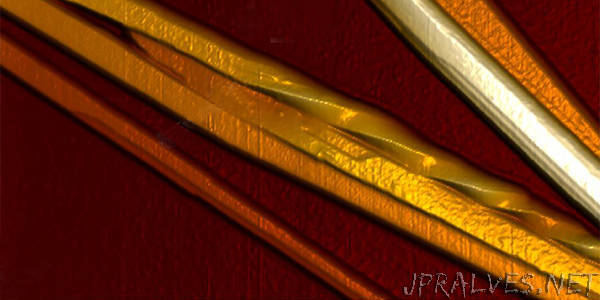
“An international team of researchers have discovered a new type of transition in protein folding: amyloid crystals formed from amyloid fibrils by a decrease in energy. The crystals are even more stable than the fibrils, which are responsible for a number of serious neurodegenerative diseases in humans.
Amyloid fibrils are infamous for the role they play in serious neurological diseases in humans, such as Parkinson’s or Alzheimer’s. One trigger for Alzheimer’s disease is the misfolding and aggregation of proteins such as tau and ABeta. This causes the formation of tiny fibrils that then accumulate in the brain. Specialists refer to these fibres as amyloid fibrils.
Raffaele Mezzenga, Professor of Food & Soft Materials at ETH Zurich, has spent a long time studying amyloid fibrils, which he synthesises in the lab starting from non-toxic and edible precursors such as the whey protein component beta-lactoglobulin. He does this by heating the proteins in acid to degrade the original structure; the proteins are “denatured” and become fibrous. Multiple individual strands congregate and twist into a helix to form the mature amyloid fibrils in the lab.
During the process, the whey proteins not only lose their original structure, but also their functionality. In the case of non-toxic food protein precursors, new functionalities are built, which are at the core of an intense research program in the group of Mezzenga.
Transformation of an amyloid fibril
An international team of amyloid experts led by Mezzenga has now made a fundamental discovery with amyloid fibrils generated by fragments of proteins from animal, human and disease related protein sources, made synthetically in the laboratory. The discovery has just been published in Nature Communications.
Under certain circumstances, the fibrils can be transformed into a protein structure that has never been observed before in-vivo and seldom observed in in-vitro studies: an amyloid crystal. The scientists resolve for the first time the physical mechanism by which this transition takes place: this involves untwisting the fibril to form elongated, matchstick-like amyloid crystals without the need to unfold and refold the protein; that is, by simply getting rid of torsional energy associated with the twisted amyloid fibrils.
In the past, researchers had only observed this phenomenon in the test tube but without really being able to identify the mechanisms leading from one structure to another; the amyloid crystals, nonetheless, have never before been found in living cells.
For the research team, it is therefore difficult to say for the time being what implications the discovery will have in the field of amyloid-related diseases. Mezzenga is already sure, however, that the results are significant for protein folding and the formation of amyloid fibrils: “Our results shed new light on the self-organisation of proteins that have a tendency to form amyloids, and on the most stable status of proteins in general.”
Nick Reynolds, Research Scientist at Swinburne University of Technology, further believes this work will have major implications in understanding the mechanisms by which amyloid proteins misfold and aggregate in neurodegenerative diseases, eventually leading to the identification of potential new routes for the early diagnosis and treatment of these socioeconomically devastating conditions.
The most stable form of protein
Indeed, once they have formed, the crystals are likely to be the most stable possible form of a protein. This is due to the fact that they have a very low level of internal energy. In terms of the energy landscape, amyloid crystals lie in the deepest valley when compared to other forms of proteins – even lower than amyloid fibrils, which were previously thought to be the lowest-energy and most stable form of protein.
Researchers have statistically and experimentally determined that energy is released when an amyloid fibril transforms into an amyloid crystal. “Our discovery means that the energy landscape of protein folding must now be revisited,” says Mezzenga.
Rarely found in nature
Yet the situation is paradoxical from a statistical physics perspective, Mezzenga continues: “If the amyloid crystal represents the lowest possible energy state of a protein form, then most proteins would have to transition to this structure sooner or later.” This is due to a well-established principle of statistical thermodynamics that states that in a system with many degrees of freedom, the state of lowest energy is the one most probable and thus most often observed. The same should hold true for proteins, which is why it is astonishing that amyloid crystals have never been found in natural systems such as cells, says Mezzenga.
Mezzenga sees the explanation for this in the fact that cells contain special proteins (chaperones) that assist proteins to fold correctly. This is an energy-intensive process. In the test tube, however, where researchers have managed to produce amyloid crystals directly from amyloid fibril precursors, these enzymes were not present. “Protein-folding in living systems is, after all, much more complex than in the test tube,” says Mezzenga.
The fundamental behaviours of amyloid fibrils are is still not entirely understood and somewhat controversial. Mezzenga hopes that his work will help to improve understanding of how proteins with a tendency to form amyloids behave and what is the natural evolution of folded protein conformations in general.”
